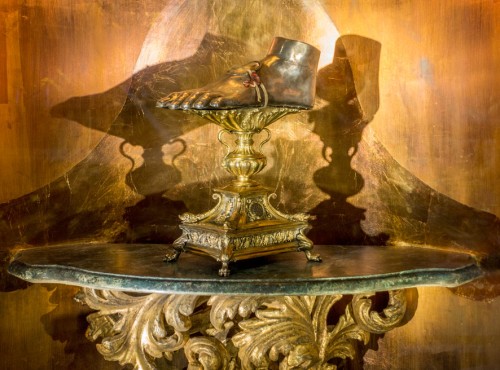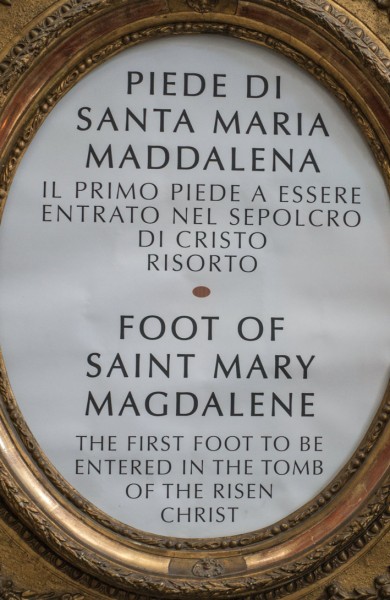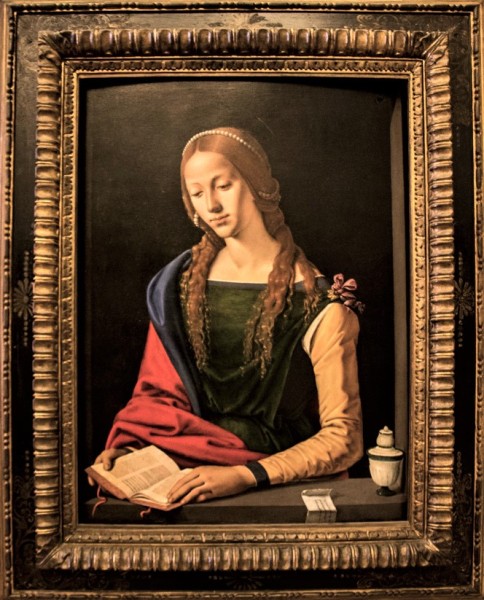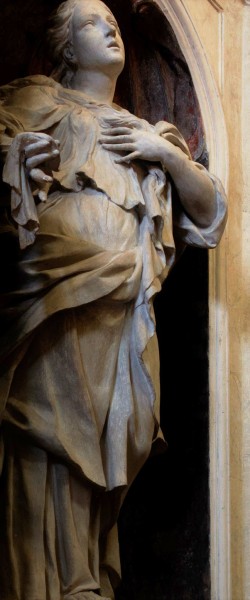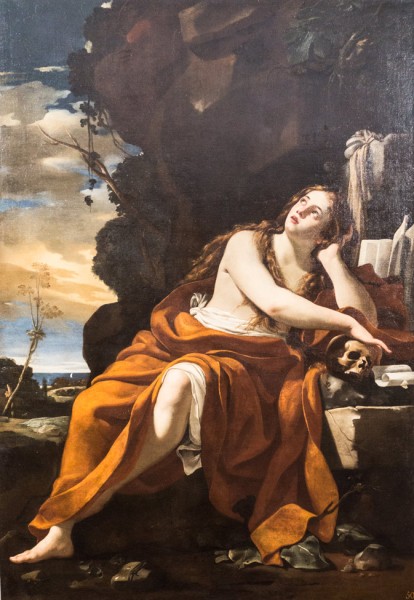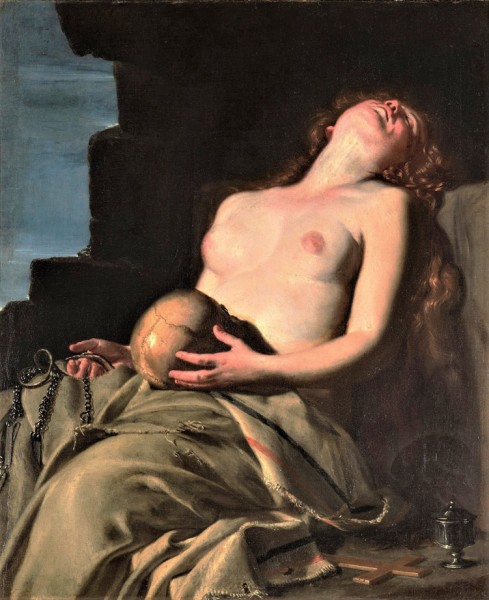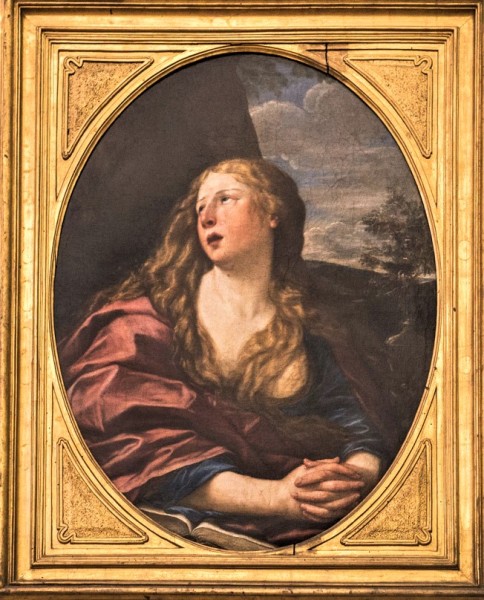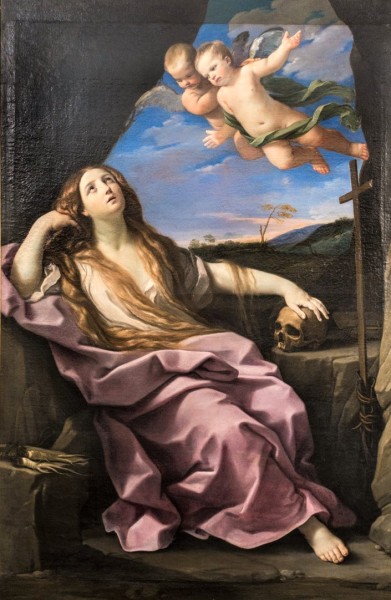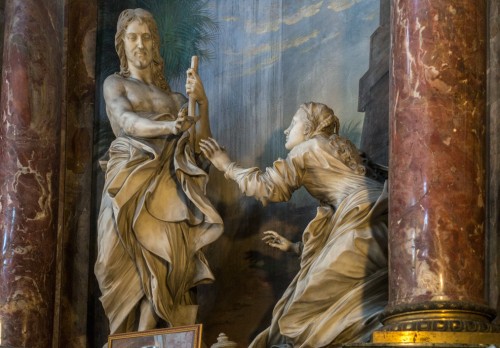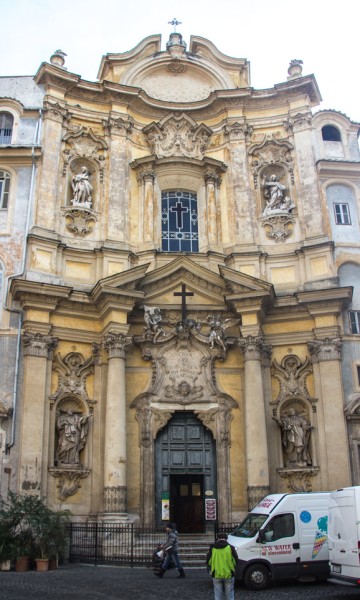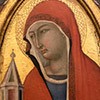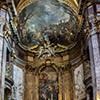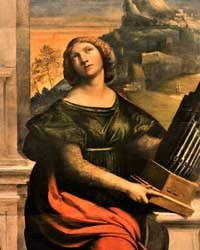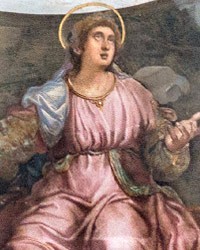Saint Mary Magdalene – a phantom figure brought to life out of ignorance, self-interest, and ill will
Let us start at the most important source – the New Testament. The popular, in Jewish culture name Mary (Mariam, Miriam) appears on the cards of the four canon Gospels (Mark, Matthew, Luke, John) numerous times and it is often not easy to differentiate one Mary from the other. We are interested in three women who bear the name, and who played a principal role in the process of the birth of the enigmatic Mary Magdalene
- Mary from Magdala came – as the name would show – from the village of Magdala located on the western shore of Lake Gennesaret. She was one of the first people who joined Christ in his travels through Galilee. This occurred when Christ banished seven demons from her body (Lk 8, 2; Mk 16, 9-11-. What exactly those demons were we do not know. Similarly to other women (Joanna and Susanna), Mary also served the group “out of their own means" (Lk 8 2-3), which means that Mary also known as Magdalene (from Magdala) supported Christ's followers financially, but we do not know how she came into the possession of everything that she had. Later, Mary accompanied Christ in the most important moment of his life – her name appears during the scene of the crucifixion; she stood under the Cross along with the Virgin Mary and St. John (Mt 27, 55-56, Mk 15, 40-41; J 19, 25-27). She witnessed the death and the burial of her master and she was the one who carried the “spices to Christ’s tomb" to wash and anoint his body on Easter Sunday. She discovered the empty tomb and she was the first person to whom Christ appeared after his resurrection, which is proclaimed in all four of the Gospels (Mk 16, 1-8; Mt 28, 1-11; Łk 24, 1-11; J 20, 1-18). She also informed his disciples about it “Mary Magdalene came and told the disciples that she had seen the Lord, and that he had spoken these things unto her” (J 20, 18). And this is the last we hear of her. The biblical message is clear – Mary from Magdala was the first person who had seen the Risen Lord and she passed on the news to others.
- The second woman named Mary appears in the New Testament in the scene of the feast. Mary of Bethany, since that is what she was called (the sister of Martha and Lazarus) during Christ’s visit sits at his feet and listens to his words (Lk 10, 38-42). She is criticized by her sister but Christ praises her readiness to listen to his teachings.
- The third figure is a nameless sinner (prostitute), who appears at the house of the Pharisee Simon (Lk 7, 36-50). She confesses her sins and washes Christ's feet with her tears, dries them with her long her, and then anoints them with valuable oil stored in an alabaster vial. And while in the Gospel according to Luke she is portrayed as a sinner, in Matthew and Mark (Mt 26, 6-13; Mk 14, 3-9), she appears simply as a nameless woman, who during a feast at the house of Simon the Leper anoints the feet of Christ with a valuable spikenard worth three hundred denarii. On the other hand, in the Gospel according to St. John, a woman by the name of Mary anoints the feet of Christ with valuable oil and dries them with her hair, during a feast at the house of Lazarus(J 12, 1-11).

Three different Marys in each of the Gospels are depicted slightly differently and in different contexts. Even the first interpreters of the Holy Scriptures (Clement of Alexandria, Tertullian, Origen, Augustine) experienced problems with this and were well aware of the vagueness of the message. Origen was the first to see three women in the text, but the others saw only one or two. Augustine, for instance, combined Mary (the sister of Martha and Lazarus) with the sinner. Only Hippolytus of Rome, who was active between the II and III centuries called Mary of Magdala Apostola apostolorum, also including other women in this group, who accompanied her to Christ's empty tomb. They were the ones who preached the words of the Savior and informed others that "He comes before them" on the way back from Galilee. The term "Apostle of the Apostles” should not surprise us. Mary from Magdala was not only a student of Christ, as were the other disciples, but also the most important, because the first witness of his Resurrection, and therefore – the repository of the mystery of the Good News and the hope for eternal life – the foundation of the Christian faith
At the end of the VI century, this problem was solved with incredible flippancy by the erudite, Benedictine, and the later Doctor of the Church – Pope Gregory the Great, who was in fact responsible for the creation of the figure of Mary Magdalene bringing together the three previously identified Marys into one whole. In his Homily 33 he wrote: “The one that Luke calls a sinner, and that John names Mary, we believe that she is that Mary of whom, according to Mark, the Lord has cast out seven demons". In this way, the pope had in fact, created a new person and filled her with new significance. Did this expert on the Scriptures commit this deed consciously, or did he make a cardinal mistake, that is difficult to say. Nevertheless, thanks to him, Mary Magdalene became flesh and blood – a woman filled with emotions and passions, an embodiment of corporeal and sinful love, for whom meeting Christ was an act of renewal. In Homily 25 Pope Gregory wrote: "A sinner, Mary has washed by her tears the defilement of her sins”. In this way the Western Christian culture was enriched by a purely abstract being, one that is intellectually and emotionally relatable because it forces us to think about hope and penance. We can only try and understand where Gregory came up with the unthinkable combination of a sinner with the most important witness of the Resurrection. The inspiration for this was probably the fact that seven demons were forced out of Mary of Magdala, which brings about the associations with the apocalyptical beast with seven heads, but also the immensity of sin, license, and sexual urges. We may also assume that Mary’s social status was not without significance: an unmarried woman, financially independent, wandering around with a group of vagabonds, as that is how the followers of Christ were perceived, did not bring to mind a proper woman, subordinate to the strong patriarchal tradition, symptomatic for the Jewish community in those times. However, she was a perfect fit for the role of a converted sinner.

Some historians see such a creation of Mary Magdalene as a manifestation of misogyny, already heard in the words of St. Paul, who would not allow women to have equal rights in the Church, teaching, and in the family, claiming: "But I suffer not a woman to teach, nor to use authority over the man: but to be in silence" (Letter to Timothy). Does, therefore, St. Paul stray from the truth in his teachings? According to the Bible, Christ distinguished Mary of Magdala – it was to her that he appeared first and told her to pass the news about his Resurrection to others. Why was this, so seldom touched upon by the Fathers of the Western Church?
In the Eastern Church, the figure of Mary of Magdala was seen quite differently. She had been revered from the very beginning, being seen as equal to the apostles. Of course, she was not connected with the figure of the sinner but rather was seen as a student and servant of Christ, the one who remained with him until the very end. According to the Eastern tradition, it was believed that after the crucifixion, she left Galilee and died in Ephesus.

On the other hand, the Mary Magdalene created by Gregory the Great took on her own form in the Western culture and numerous legends and myths came with it. Another part of the spectacle with her as the main protagonist appeared in the middle of the XIII century due to the widespread popularity of The Golden Legend by the Italian hagiographer and the archbishop of Genoa Jacobus de Voragine. What had until then been confusing, thanks to his book became clear, and on top of them was served in an easy-to-digest sauce of anecdote. He writes: “Then when Magdalene abounded in riches, and because delight is fellow to riches and abundance of things; and for so much as she shone in beauty greatly, and in riches, so much the more she submitted her body to delight, and therefore she lost her right name, and was called customably a sinner”. Later, (according to the hagiographer) she expressed remorse and thanks to her transformation she became one of the closest followers of Christ. Jacobus also, freely adds the rest of her story. On the pages of his book, he sends her from Palestine to Provence, where Mary Magdalene teaches, and then for the next thirty years hides away in a cave and these are years spent on penance and prayer. There, she is fed by angels who bring her food seven times a day. In the early Middle Ages in the location of the "holy grotto" in the Sainte-Baume Mountains, a sanctuary was created, while the saint herself allegedly was buried in the nearby Saint-Maximin-la-Sainte-Baume Monastery. It attracted pilgrims from all over Europe, including the curious Queen Louise of Savoy (the mother of the King of France Francis I), who desired to learn more about the saint who was venerated there. And it was at this moment that problems began to abound.
One of the historians who was employed by the queen to study the fate of Mary Magdalene was Jacques Lefèvre d’Étaples – a humanist, a Parisian librarian, and an expert on the Bible. On the pages of his treatise De Maria Magdalena Triduo Christi. Et e tribus una Maria disceptatio (Paris, 1517), he distinguished three women named Mary, showing the falsity of the story about a saint sinner. Since his work was published, during the period of the struggles of the Catholic Church with the Protestants – who ridiculed the fabled lives of saints – the historian had no chance to succeed. The Paris University criticized and denunciated his treatise and he himself was almost accused of heresy. His work was quickly forgotten, while the already well-in-place tradition of Mary Magdalene the sinner continued to take on a life of its own and was even strengthened further, especially during the time of the Counterreformation. It was then, that Mary Magdalene became one of the most often used subjects of Baroque art, and while previously her sexual charm had been sparsely used, rather emphasizing her participation in mourning Christ under the cross or the scene of her meeting the Resurrected Lord (Noli me tangere), in the XVII century it became a standard to show her semi-nude body, long, flowing hair covering her bare breasts, and teary, looking up at the sky eyes. It is obvious that her beautiful, sensual body was the principal topic of countless works created at that time.

The next person to occupy himself with the issue of Mary Magdalene was, at the end of the XVII century, the French clergyman and thinker Jacques-Bénigne Bossuet. In a lapidary way, on only three pages of his treatise, he once again distinguished three Marys in the Bible. However, he also was unable to get through to the mainstream teachings of the Church. The Church itself never officially contradicted the truth about Mary Magdalene, but it allowed the tradition identifying her with the sinner to run its course.
A change in this policy only took place in the XX century. After the Vatican Council (1969), Mary Magdalene's honor was restored, her role in the paschal events was once again appreciated and she was separated from the Biblical sinner and Mary of Bethany while getting her own separate feast day (22nd July).

Still, this did not stop the interest in her persona in art and pop culture. The idea behind creating subsequent legends and myths about her came from the information contained within gradually discovered several early Christian texts. These apocrypha, known as the Gnostic Gospels, were created in the II and III centuries and were discarded during the creation of the Christian doctrine (IV century). Ultimately, they did not become part of the canon of officially recognized gospels (these as we know are limited to four: according to the saints Mark, Matthew, Luke, and John). Forbidden and systematically destroyed, today they are a testimony of the existence of various trends and intellectual currents alive among the faithful at the beginning of the creation of Christian thought. The interest in Mary Magdalene once again grew upon the discovery of fragments of the so-called Gospel of Mary. This text shows Mary (of Magdala) as the most trusted student of Christ, the one who best understood his message and a person who achieved enlightenment inaccessible to the other disciples. She was to study the mystery of the Truth preached by the Savior after his departure and explain it to others, including the apostles. On the pages of this gospel, we can also read the words of St. Peter saying that Christ, "loved her more than us" (1, 126). From yet another Gnostic text discovered in 1945 Gospel of Philip, we find out that Christ "kissed her (Mary of Magdala) on the mouth”. And here we are only a step away from the legends created during the times of contemporary pop culture. The best example of this is Dan Brown's book The Da Vinci Code – which suggests that Mary Magdalene was not only the wife of Christ but also the mother of his children.

Looking for traces of Mary Magdalene in Rome, we will not be disappointed. A late-Baroque church, the Santa Maria Maddalena (Campo Marzio) was erected in her honor. On the walls of museums and church chapels, we will find her numerous images, and when we would like to be transported into the aura of her cult in a purely devotional dimension, it is enough to enter the Church of San Giovanni dei Fiorentini, on the banks of the Tiber River. There, near the altar, we can find the relic of her foot stored in a gilded reliquary. As tradition would have it, the earthly remains of Mary Magdalene were at the end of the IX century transported from Ephesus to Constantinople. From there, they were stolen by the Crusaders (beginning of the XIII century) and for a period of time were in Rome, where a foot was separated from the rest, while the whole soon found its way to the tomb found in the Monastery of Saint Maximin-la-Sainte-Baume in Provence.
In 2016, Pope Francis once again referred to Mary Magdalene as the "Apostle of the Apostles". Today, we would like to see in her – similarly to the Bible – the woman who bore the Good News of Christ's Resurrection to people, but will that destroy the attractive image of a beautiful repenting sinner, which has been around for centuries?
If you liked this article, you can help us continue to work by supporting the roma-nonpertutti portal concrete — by sharing newsletters and donating even small amounts. They will help us in our further work.
You can make one-time deposits to your account:
Barbara Kokoska
BIGBPLPW 62 1160 2202 0000 0002 3744 2108 or support on a regular basis with Patonite.pl (lower left corner)
Know that we appreciate it very much and thank You !

